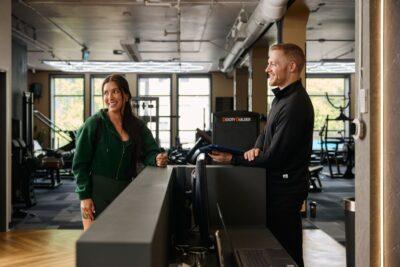There’s nothing quite like the thrill of turning your passion for fitness into a thriving business. If you’re thinking about opening a gym, you’ve come to the right place!
If you’re asking the question “how to open a gym?” then you’re already halfway there. Whether you see yourself opening a bespoke Pilates studio or running a high-energy training facility, this guide will put you in the right headspace.
Opening a gym is exciting—but it also comes with a learning curve. You have to make endless decisions and plan like a pro. You’ll have to build budgets, secure permits, choose equipment, and market your launch.
There’s a lot to do before you open your doors.
Don’t sweat, we’ve got you covered. We’ll walk you through every major step so you can move from grand idea to grand opening with confidence.
Ready to open your dream gym? Roll up your sleeves and let’s get started.
How Much Does It Cost to Open a Gym?
One of the biggest questions people have when opening a gym is, “How much is this going to cost?”
The truth is, gym startup costs vary depending on the size, location, and type. It doesn’t matter whether you’re starting a grassroots dance studio or have Equinox-level aspirations. Either way, you’ll need a clear budget.
Here’s a breakdown of typical gym startup costs:
What You Need | Estimated Cost Range |
Lease or purchase of space | $6,000–$10,000/month |
Renovations and build-out | $20,000–$100,000+ |
Fitness equipment | $10,000–$100,000+ |
Licensing, permits & insurance | $5,000–$15,000+ |
Staffing and payroll | $30,000–$60,000/year per employee |
Marketing and branding | $5,000–$20,000+ |
Gym management software | $150–$300/month |
Total estimated cost | $50,000–$250,000+ |
[Figures from: Zintego, Fit Small Business, US Small Business Administration, Insurance Bee, Bureau of Labor Statistics, and ABC Glofox.]
If you’re building a gym from the ground up, these numbers can climb even higher—especially if you’re looking at a large space including showers, locker rooms, or retail areas.
Another path to consider is franchising. While the initial investment may be higher—ranging from around $350,000 for F45 to over $1 million for Planet Fitness—franchises help you save on branding, equipment sourcing, and site selection. You’ll also benefit from access to a proven business model and get treated to ongoing operational support. All of this reduces guesswork and makes it easier to open your own gym with confidence.
(Pro tip: Buying used or refurbished equipment can save you thousands without sacrificing quality!)
Regardless of the route you choose, the first step is a detailed gym business plan template and budget. We’ll cover all this and more in the next section, along with a helpful opening a gym checklist to keep you organized and focused.
⬇️ Download the FREE e-book: 6 Steps to Opening a Gym or Fitness Studio
How to Open a Gym: Must-Have Checklist
Opening a gym is a big commitment and a big opportunity. From legal paperwork to equipment choices, there are a lot of moving parts. We’ve organized our checklist for opening a gym into four categories to help make sure you don’t forget any crucial pieces.
Just like our award-winning software, this list will help you stay organized, avoid mistakes, and build a foundation for growth.
#1: Plans and paperwork
From research to planning and funding, there’s a lot that happens before you even switch on the lights! Here’s a checklist of first steps as you begin to build your business:
- Research your market and competitors (if you know your target market and your main competition, you’ll better meet your members’ needs)
- Write a flawless gym business plan
- Choose your business structure, and get a license and tax ID number
- Secure funding (learn more about gym financing)
- Get a certificate of occupancy to prove your space is safe and up to code
- Get the necessary health and safety inspections
- Secure general liability insurance (plus workers’ compensation if you hire staff)
- Secure local permits like zoning approval, signage, and fire safety
Requirements vary by location. It’s smart to consult with a local small business attorney or accountant to ensure compliance. Check out the U.S. Small Business Administration for guidance based on your state and industry.
#2: Location, location…equipment!
Your gym’s success begins with where it’s located and how well it’s equipped. Here are a few tips to get these key factors right:
- Choose a space with high foot traffic or easy parking
- Consider the type of gym you’re opening—boutique studio, strength training gym, hybrid space, etc.
- Make sure your gym type aligns with your target demographic and their wants/goals (young professionals, parents, older adults, etc.)
- Review your lease terms closely, especially build-out rights, signage restrictions, and early-exit clauses
- Choose high-quality machines and functional fitness gear
- Factor in delivery, assembly, and maintenance costs
Pro tip: Franchises often provide bulk discounts on equipment and offer a gym setup checklist you can follow from day one.
“I went and [opened a gym] because I never really thought of going on any other path. To me, it was just like this is where I want to be. This is where I want to spend my time. This is what I want to do.” – Mike Lipowski, founder and owner of Pure Physique
#3: Staff and systems
You can’t do everything yourself. Hiring qualified staff and trusting them to own key responsibilities is a huge part of running a successful gym. You’ll also want to make sure day-to-day operations run smoothly. Here’s how:
- Recruit certified and skilled trainers and friendly front-desk staff who align with your gym’s values and culture
- Create a standardized onboarding process and provide regular training to ensure consistent service quality
- Clearly outline job duties to avoid confusion and keep workflows efficient
- Delegate tasks like scheduling, front desk duties, and social media
- Use a gym management platform (like ABC Glofox) to handle scheduling, billing, member communication, and reporting
- Document daily tasks (e.g., opening/closing checklists, cleaning schedules, emergency procedures) to keep operations consistent and scalable
#4: Spread the word
You could have the best gym in town, but it won’t grow if no one knows about it. Here’s how to get the word out and bring in your first 100 members:
- Build a pre-launch marketing plan at least 60 days before opening
- Create a simple, mobile-ready website with a widget for online sign-ups
- Promote your gym opening on social media and with local ads
- Offer limited-time founding member discounts or referral rewards
- Partner with nearby businesses (like smoothie bars or physios) for mutual promotion
Marketing is ongoing, so set aside a budget for monthly campaigns. Complete the picture with a gym management toolkit like ABC Glofox that offers built-in marketing tools.
Tips for Running a Successful Gym Business
Once your gym is up and running, the real work begins: keeping the chain well-oiled for the long road ahead. From managing your team to delivering a standout member experience, how your gym runs from Monday to Sunday packs an even bigger punch than the launch party your community is still talking about.
For newbies and experienced fitness veterans alike, these tips will help you build a gym that runs like a freshly-tuned spin bike—keeping members happy and giving you room to grow.
Build a welcoming culture
Your gym might have the best equipment in town, but if the vibe’s off, members won’t stick around. Build a “members first” gym that feels like a second home—clean, friendly, and motivating. This includes:
- Greeting members by name
- Keeping locker rooms and equipment clean
- Offering group classes or events to build community
- Responding quickly to feedback or complaints
Retention starts with relationships, and satisfied members will become your best promoters.
📝 Read More: 7 Operational Tasks You Should Automate in Your Fitness Studio (and How Much Time You’ll Save)
Stay on top of maintenance
Preventive maintenance saves time, money, and member frustration. Create a regular schedule to inspect and service your equipment, HVAC system, and high-traffic areas. Keep cleaning supplies stocked and delegate daily walk-throughs to keep everything ship-shape.
A clean, well-maintained gym keeps your facility safe, functional, and appealing.
Automate your admin
From processing payments to sending class reminders, the right systems can save you hours each week. That’s where gym management software like ABC Glofox becomes a game-changer!
Automating key tasks allows you to:
- Simplify billing and member check-ins
- Schedule classes and track attendance
- Send automated emails or texts for promotions and reminders
- Manage bookings and cancellations in real time
This is how the most successful gym owners stay focused on growth while their systems handle the details. Instead of drowning in admin, you can focus on growing your business, supporting your team, and delivering an even better member experience.
Know your numbers, track performance, and adapt
What gets measured gets managed. Keep an eye on key metrics like monthly recurring revenue (MRR), churn rate, member referrals, and class attendance. Use these insights to improve your offerings, tweak your pricing, or adjust staffing.
Gym software makes this easier by giving you access to real-time reporting and performance dashboards—all in one place.
📝 Read More: Everything You Need to Know About Gym Financing
FAQ: How to Open a Gym
How much will it cost to start a gym?
The cost to start a gym ranges from $50,000 to $250,000 or more, depending on the type of facility, location, size, and equipment. Smaller personal training studios start on the lower end, while luxury gyms or franchise locations will track much higher.
Is opening a gym a profitable business in 2025?
Yes! Opening a gym can be profitable in 2025, especially with the growing demand for health and wellness services. That said, how profitable you’ll be depends on overhead, pricing, retention, and operational efficiency. Tools like gym management software can improve margins by reducing admin time and super-charging growth.
How do I start my own gym?
To start your own gym, begin with a solid business plan. Define your niche, research your local market, estimate your startup costs, and secure funding. Next, find a location, buy equipment, get the necessary licenses and insurance, and begin marketing your launch.
Need help getting started? Download our complete business plan template here.
What are the steps to open a successful gym business?
Here’s a simple breakdown in case you don’t have time to read the whole blog:
- Research your market and competitors
- Write a gym business plan
- Choose your business structure and register it
- Secure funding
- Get licenses, permits, and insurance
- Find a location and buy equipment
- Hire staff and set up systems
- Start your marketing
- Open your gym and focus on member retention
How much money do I need to start a gym?
You’ll need at least $50,000–$100,000 in starting capital to open a small or mid-sized gym. Larger or franchise gyms can cost upwards of $500,000. Costs include rent, build-out, equipment, staffing, software, and marketing. Review your budget before you launch.
What equipment do I need to open a gym?
It depends on your gym type, but most gyms need:
- Free weights and barbells
- Cardio machines (treadmills, bikes, rowers)
- Resistance machines and racks
- Mats, bands, and functional training tools
- Cleaning and sanitation supplies
Use your business model to guide your equipment needs (e.g., strength-focused gyms need more lifting equipment, while studios may need less.)
Do I need a license or permit to start a gym?
Yes, opening a gym usually requires a business license, liability insurance, and a certificate of occupancy. Depending on your state or city, you may also need zoning approval, fire and health inspections, and signage permits. Always check with your local government and small business associations to make sure you’re compliant.
Ready to Open Your Gym? Take the Next Step with Confidence
Opening a gym is an exciting journey with plenty of ups and downs—and the potential for huge rewards! With the right planning, tools, and support, you can turn your vision into a thriving fitness business that serves your community and fuels your passion.
That’s where ABC Glofox comes in. We built our all-in-one gym management software for fitness business owners like you, helping simplify your day-to-day operations, automate tedious tasks, and give you more time to focus on growing your gym—and creating a space your members can’t get enough of.
Don’t just open a gym—start something unstoppable.














